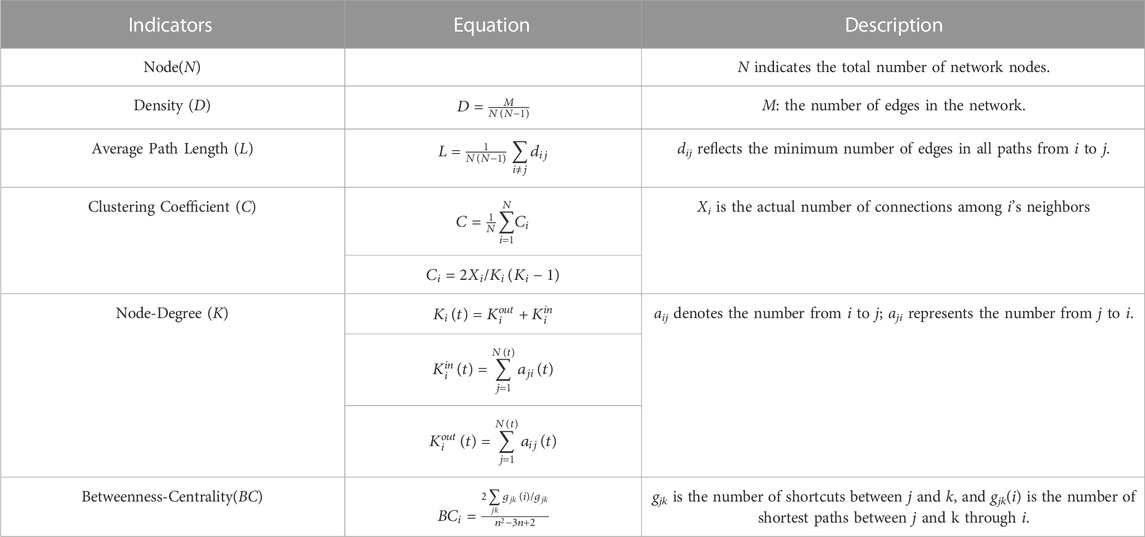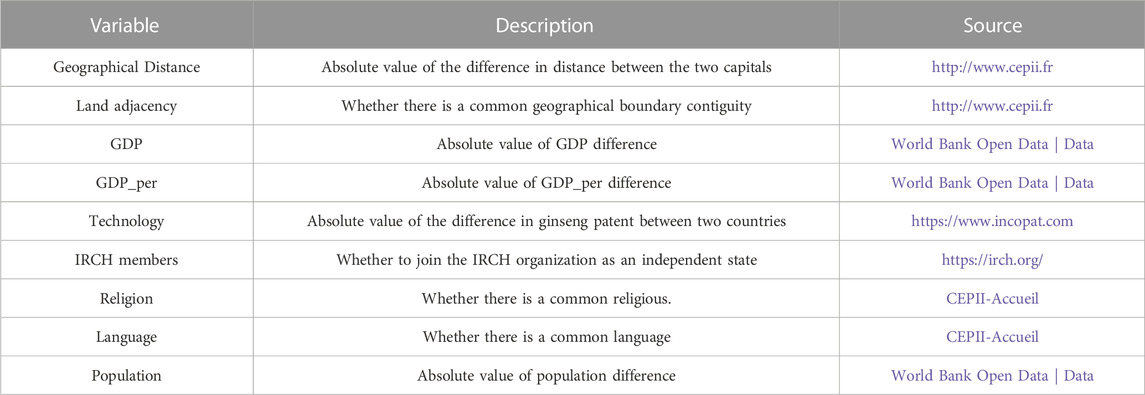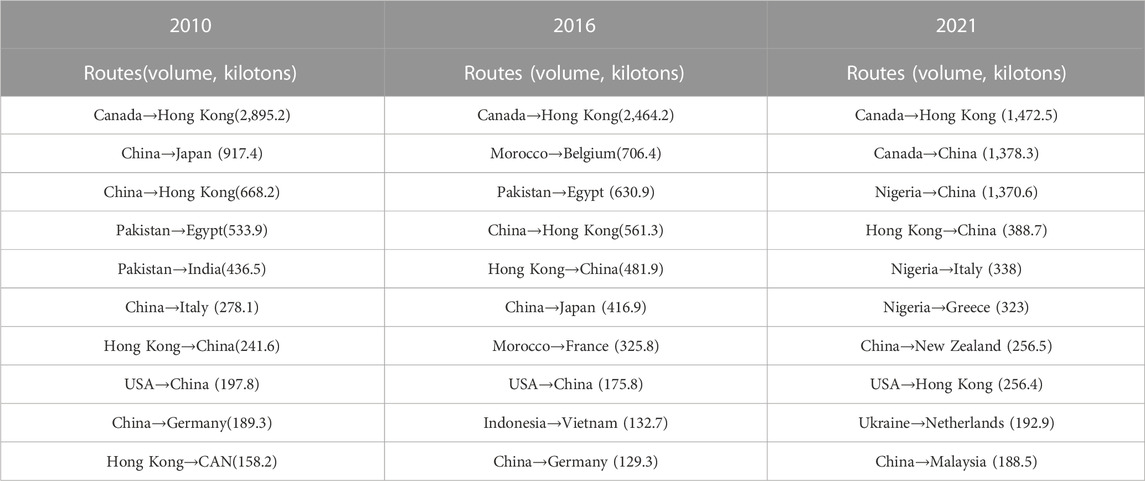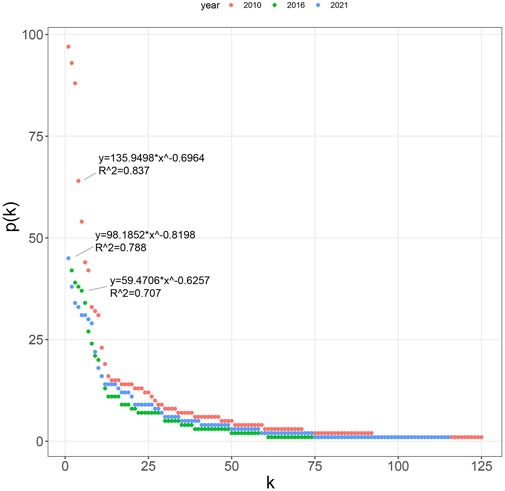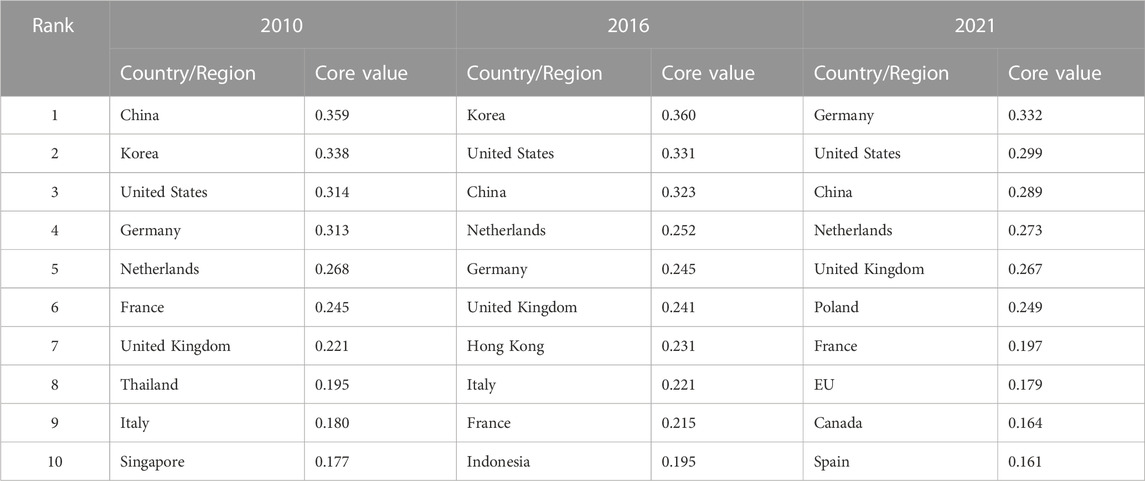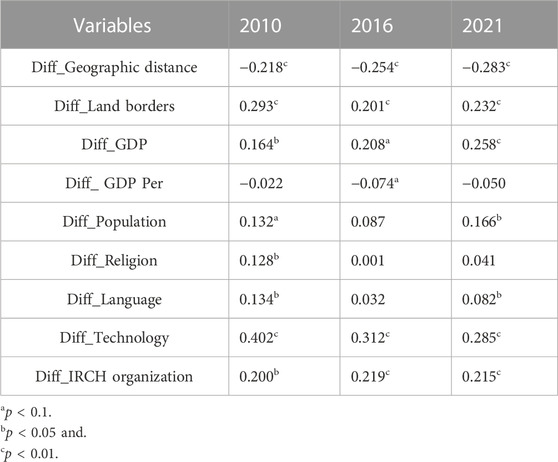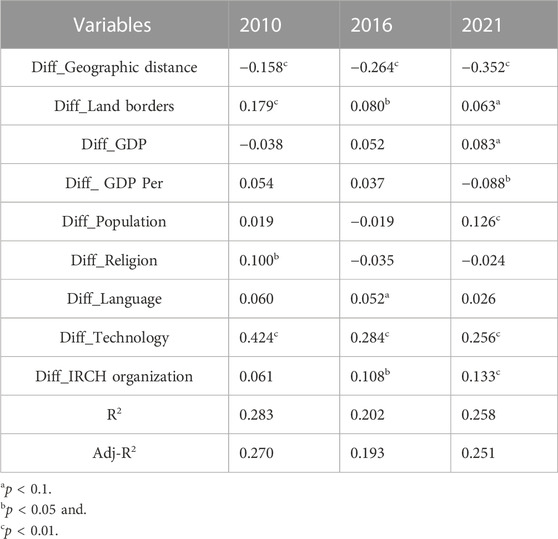- 1School of Economics and Management, Anhui University of Chinese Medicine, Hefei, Anhui, China
- 2Institute of Chinese Medicine Resources Protection and Utilization, Anhui Academic of Chinese Medicine, Hefei, Anhui, China
- 3School of Pharmacy, Anhui University of Chinese Medicine, Hefei, Anhui, China
Background: Ginseng is a rare and highly valued Chinese materia medica with a rich trading history and has a wide range of application, including medicine, food, healthcare, and daily chemical production. However, the global trade of ginseng exhibits diverse features and uneven development across different countries and regions. Surprisingly, the intricate network relationship and the underlying characteristics and influencing factors of ginseng trade networks remain unexplored.
Methods: This study analyzed ginseng trade data obtained from the UN-Comtrade database and used social network analysis to construct global ginseng trade networks. To elucidate the structural characteristics, we analyzed the indicators of the overall network structure and node attributes. Core-periphery analysis is used to examine the evolutionary patterns within the global ginseng trade networks. Furthermore, we apply the quadratic assignment procedure to investigate the impact and relevance of spatial proximity, cultural differences, economic indicators, population size, technological similarity, and institutional distance.
Results: The findings reveal that the global ginseng trade networks exhibit typical small-world and scale-free properties, as well as a core-periphery structure. Several core countries, including China, South Korea, Germany, and the United States, exert significant control over both trade volume and trade partners. South Korea and China initially occupied central positions in the export market due to their resource endowments, their prominence has gradually diminished with the ascendancy of Germany and the United States. According to the core-periphery analysis, the ginseng trade has shown a gradual concentration within specific trade groups comprising core and semi-periphery countries, most of which are along the “Belt and Road” religion. We also found that geographic distance and GDP per capita exert negative effects on ginseng trade, while factors such as land adjacency, technology and economic gap, population size, and institution similarity play significant positive roles.
Conclusion: The global ginseng trade has experienced increasing concentration and close linkage among a limited numbers of participants. It is crucial to pay close attention to the relationship between ginseng industry development and resource conservation. Strategies such as expanding trade channels, implementing trade substitution measures, and optimizing the quality and standards of ginseng products can effectively enhance trade security.
1 Introduction
Ginseng (genusPanax, family Araliaceae) is a valuable medicinal plant with a rich history of medicinal and edible use. Medical application of ginseng was first found in the Shen Nong Ben Cao Jing (Shen Nong’s Herbal Classic) over 2000 years ago. In 1,596, the Compendium of Materia Medica written by Li Shizen recognized ginseng as a “superior tonic” compared to other herbal remedies (So et al., 2018). The word “ginseng” is originated from a Chinese word meaning “man-herb” while the word “panax” means “cure-all” in Latin, highlighting its reputation as a potent plant capable of treating various diseases (Choi et al., 2015). The root of the ginseng plant is particularly prized for its medicinal properties, containing polysaccharides, saponins, volatile oil, trace elements, organic acid, proteins and other chemical compositions. Ginseng is known for its effectiveness in replenishing primordial Qi, tonifying the spleen and lung, generating body fluids, calming mind and enhancing intelligence (Xin et al., 2021). Modern pharmacology research has revealed that ginseng exerts notable effects on the immune system, central nervous system, cardiovascular system, metabolism, infectious and neoplastic diseases (Chen et al., 2008; Choi et al., 2015; Mancuso and Santangelo, 2017). As a result, ginseng and its products are widely used for eliminating fatigue (Kim et al., 2013), improving cognition (Geng et al., 2010; Scholey et al., 2010), treating depression (Jeong et al., 2015), preventing memory deterioration (Chen and Hui, 2012; Ossoukhova et al., 2015), alleviating diarrhea and shortness of breath (Lee et al., 2012) and combating fatigue (Yennurajalingam et al., 2015). In addition to serve as medical supplies, ginseng is also consumed as dietary supplement and functional food. Its popularity has made ginseng one of the most widely used herbal remedies worldwide.
Thirteen species of ginseng have been identified, but the most commonly utilized are the Panax ginseng Meyer, grown in China and Korea, and Panax quinquefolius, cultivated in the United States (Virginia, Wisconsin) and Canada (Ontario, Quebec) (Szczuka et al., 2019). The distribution of ginseng is uneven around the world, due to geographical, environmental and economic factors, resulting in significant spatial and temporal difference between major producing nations and others. China is the largest producer of ginseng, followed by South Korea, Canada and the United States and their total production accounts for over 99% of global ginseng production (Baeg and So, 2013). The resource distribution imbalance can be mitigated through close international trade cooperation, which has played a crucial role in compensating for the disparities. Countries with resource advantages enhance their domestic production capacity and earn foreign exchanges, contributing to the sustainable development of their economies. Conversely, countries with limited resources but advanced processing technology and substantial market demand can acquire low-priced raw materials through trade, enabling them to achieve higher profits. Ginseng trade has a long and prosperous history. Historical records show that a considerable portion of ginseng in China originated from ancient Korea during the North and South Dynasties (Zhan et al., 2021). Ginseng exports facilitated economic and trade exchanges between ancient Korea, China and Japan, serving as a vital source of foreign trade income for ancient Korea and a substantial part of China’s tribute trade during Qing dynasty (Flagg, 2021). Ginseng is also regarded as a connection of Chinese-Canadian (Gotlieb, 1985) and Chinese-America relations (Carlson, 1986) dating back to the 18th century. With the growing global interest in alternative medicine and health foods, ginseng trade is projected to reach approximately $17.7 billion by 2030, with a compound annual growth rate (CAGR) of 10.4% from 2022 to 2030 (Fan et al., 2023). The United States ginseng market is estimated to reach $423.9 million by 2030, while the Chinese market is expected to reach $6.3 billion (Baeg and So, 2013; Xiang et al., 2022).
Academic discussion on ginseng trade have primarily focused on the current export structure, export value and export markets (Flagg, 2021; Zhan et al., 2021). However, the global ginseng trade networks (GGTNs) exhibit distinct features and uneven development across different countries or regions. The countries or regions involved in ginseng trade maintain intricate relations, forming a complex system. The trade network characteristics and influencing factors of ginseng trade relationships are still not well understood. Social Network Analysis (SNA) provides a powerful tool for analyzing complex trade relationships by constructing trade networks, extracting core subnets based on trade weights, and studying the structure and attributes between nodes. SNA research has demonstrated typical characteristics such as scale-free distribution, small-world characteristics and high clustering coefficients in international trade relations (Serrano and Boguñá, 2003; Zhong et al., 2014). Trade characteristics have been analyzed by network density, clustering coefficients, and average path length (An et al., 2017). Further investigation carried by Newman and Park (2003); Fagiolo et al. (2009) aimed to study the topological characteristics of trade network, and revealed the core-periphery structure. The dynamics of international trade have also been a key focus for scholars, with previous studies exploring factors affecting trade cooperation using the classical gravity model. Hasson and Tinbergen (1964) were the first to apply the gravity model to international trade research (Leibenstein, 1966). Subsequently, factor endowments (Bergstrand, 1989), economic size (Ristanovic et al., 2020), common borders (Vu et al., 2020) and regional trade agreements (Sui et al., 2021) have been incorporated into the gravity model. The impacts of aging demographics and geographical distance on trade have also been discussed (Liu and Tsai, 2022). However, these studies only partially explain the influencing factors of trade, as they fail to consider the interrelationships between these factors and whether their impacts on trade are influenced by other factors (Fagiolo, 2010; Kabir et al., 2017; Yotov, 2022). Standard statistical procedures are inadequate for parameter estimation and statistical tests, due to the risk of calculating incorrect standard deviations. To address this issue, scholars employ randomized detection methods to test, and quadratic assignment procedure (QAP) is one such approach. QAP compares the similarity of each element in the two matrices, calculates the correlation coefficient between the matrices, and conducts non-parametric test on the coefficient (Dekker et al., 2007; Xu and Cheng, 2016). QAP mitigates problems related to multi-collinearity and structural autocorrelation. Over the past decade, researches combined SNA with QAP have accumulated substantial research experiences and cases, such as crude oil (Guan et al., 2016; Wu and Chen, 2019), fossil energy (Gao et al., 2015; Li et al., 2015), electricity (Ji et al., 2016), etc. However, ginseng trade has not been studied using this approach.
To address this knowledge, this paper aims to use SNA to establish GGTNs and study the network structures and node attributes. Additionally, we adopt QAP to explore the determinants of GGTNs. Our research seeks to answer the following questions: What is the scale of GGTNs? What are their structural characteristics? Whether ginseng networks also have scale-free distribution, small-world characteristics and high clustering coefficients? What are the determinants of GGTNs and how do these factors influence trade relationships? The remainder of this paper is organized as follows: Section 2 introduces the method and data sources. Section 3 focuses on empirical analysis and provides a reasonable explanation of the results. Section 4, 5 concludes discussion and conclusion, respectively.
2 Materials and methods
2.1 Research methodology
2.1.1 Network construction
In this study, we utilize UCINET 6.504 software to construct a weighted network for GGTNs. Each node in the network represents a country, the edge Eij represents the trade relation between country i and j. If there is no trade relationship between country i and j, then Eij = 0, otherwise, Eij = 1. The trade volume from country i to j is denoted as Wij (Wang et al., 2020). In this study, the trade volume is measured by physical values. Considering the asymmetries in the trade data, we adopt the maximum value as the weight of the edge between countries i and j, following previous studies (Hu et al., 2020).
2.1.2 Statistic indicators
To describe the structural characteristics of GGTNs, this paper sets up two levels of indicators. Firsty, the overall structural features of the network are depicted as follows. The number of network nodes (N) represents the number of countries in GGTNs. Density (D) describes the level of interconnection between nodes. A higher network density indicates a higher level of commercial activity. Average path length (L) is the average number of nodes that need to be traversed to reach from one node to another in the network. The clustering coefficient (C) reflects the degree to which a node is connected to its neighboring nodes. If the network exhibits a shorter average path length and a larger clustering coefficient, it indicates the presence of the small-world property (Nobi et al., 2020; Reyes and Laroze, 2022). Secondly, the structural features of the nodes are depicted through their node degree and betweenness centrality. Node degree (K) refers to the number of nodes directly attached to a specific node in GGTNs and can be further divided into out-degree and in-degree in a directed network. In this study, the node degree for the year 2010, 2016, and 2021 are ranked from small to large, and the distribution curves reflecting the degree of heterogeneity are plotted (Fu et al., 2021). Betweenness centrality (BC) is a measure of the probability that the shortest path between other nodes pass through a particular node in GGTNs, reflecting its control ability. The data are shown in Table 1.
2.1.3 Core-peripheral analysis
Core-peripheral analysis is used to analyze the evolutionary characteristics of GGTNs, which identifies closely connected centers as well as scattered peripheries. The algorithm for core-peripheral analysis was first proposed by Borgatti and Everett and can be categorized into discrete and continuous model (Borgatti and Everett, 1999; Yanchenko and Sengupta, 2022). In this study, we adopt a continuous core-peripheral model to analyze the evolutionary characteristics of GGTNs by calculating the cores of each node. The specific calculation formula is as follows:
In calculation formula, Ci and Cj represent the cores of nodes i and j, respectively. δij represents the element of the pattern matrix δ corresponding to the ideal core-edge model, while aij represents the element of the actual adjacency weight relation matrix. The correlation index ρ measures the correlation between the pattern matrix and the actual adjacency matrix. When ρ reaches the maximum value, δ represents the edge-core structure matrix that closely approximates the actual situation and corresponds to the nearest quasi-ideal model (Elliott et al., 2020).
2.1.4 QAP analysis and factor selection
QAP analysis is a randomized detection method that consists of correlation analysis and regression analysis. The correlation analysis examines the relationship between each influencing factor and the trade network, while the regression analysis investigates the statistical significance and magnitude of these influencing factors (Liu, 2004). The QAP algorithm proceeds in three steps. Firstly, it calculates the Pearson correlation coefficient between corresponding cells of the two data matrices. Secondly, it randomly permutes rows and columns of one matrix and recalculates the correlation and other measures. Lastly, step 2 is repeated thousands of times to determine the proportion of times the randomly generated measure is equal to or greater than the observed measure calculated in step 1.
The first factor influencing GGTNs is spatial proximity, which includes geographic distance and common border. The geographic proximity between economic entities plays a significant role in determining trade linkages, as it helps to reduce transaction costs. Studies conducted by Anderson and Wincoop have demonstrated an inverse relationship between trade volume and geographical distance (Anderson and Van Wincoop, 2003). Additionally, a common land border is considered as a crucial factor in measuring trade cost, serving as a proxy variable for geographical distance. The second factor is cultural similarities. Language and religion, as core components of cultural connotations, directly impact the way and cost of communication in international trade. Shared cultural contexts facilitate a reduction in information acquisition costs and cognitive blind spots on both sides, leading to improved credit enhancement and increased international trade (Walker, 2018). The third factor is the economy and population. Countries with similar economies and populations often share similar consumer preferences. The level of personal income also influences consumption pattern. Duan et al. (2021) hold the view that food consumption patterns change with rising incomes, leading to an increased per capita food consumption. The fourth factor is technological similarity. Countries with high technological similarity are more likely to establish cooperative relations and there is active trade between countries engaged in close technical cooperation. The final factor is institutional distance, which can result in trade friction. The diversity of the national drug surveillance system means that ginseng trade has gone beyond commercialization and is also influenced by political and cultural dynamics. The International Regulatory Cooperation for Herbal Medicines (IRCH), established in 2006, is a global organization of medical plant regulators. In this study, IRCH membership is used as a proxy variable for institutional distance. The definitions and data sources of these factors are described in Table 2.
Based on the above analysis, we propose the following hypotheses on the factors influencing GGTNs:
Hypothesis 1 (H1). Countries that are geographically closer or with common geographical boundaries are more likely to trade with each other.
Hypothesis 2 (H2). Countries shared common culture background, such as language or religion, are more likely to trade with each other.
Hypothesis 3 (H3). Countries with similar economies and populations are more likely to trade with each other.
Hypothesis 4 (H4). Countries with high technological similarity are more likely to establish cooperative relations.
Hypothesis 5 (H5). IRCH members are more likely to trade with each other.
According to the above analysis, the model constructed in this study is as follows:
T = f (Diff_distance, Binary_border, Binary_language, Binary_religion, Diff_GDP, Diff_GDP_per, Diff_population, Diff_ technology, Binary_IRCH)
where the dependent variable T represents the matrix of GGTNs, Diff_distance, Diff_GDP, Diff_GDP_per, Diff_population and Diff_technology are matrices that represent the absolute differences in the corresponding indexes. These five variables are standardized by the columns of the matrix. Binary_border, Binary_language, Binary_religion, Binary_IRCH are binary matrices. If two countries are the same, the value takes 1, otherwise it takes 0.
2.2 Data resource
To investigate the dynamic changes in ginseng trade, trade data from the UN-Comtrade database spanning from 2010 to 2021 were extracted. Data prior to 2010 were not included in the analysis due to the limited number of countries involved in ginseng trade and the small trade volume during that period. The specific trade data for ginseng root is identified by the HS code HS121100. Trade related to ginseng extracts was not analyzed as there was no corresponding HS code available. In order to present the main structure of GGTNs more clearly, certain countries with low trade volumes were excluded from the analysis. Re-export and re-import quantities were not considered, because of their tiny proportion in the overall trade. China and Hong Kong China were separately included in this study. Table 2 presents the variables used in QAP analysis. Data on GDP, GDP_per capita and total population were acquired from the World Bank database. Geographical distance, land boundary, language and religion were obtained from the Cep II database. Technology differences were measured by the absolute value of the difference in ginseng patents. As ginseng is a botanical medicine, the inclusion of independent countries in IRCH organization is also considered in the model.
3 Results
3.1 A synopsis of GGTNs
Over the past decade, the trade volume of ginseng has remained relatively stable. This can be attributed to the stringent growing conditions of ginseng and the limited number of producers. The trade volume initially increased from 9.5 million tons in 2010 to a peak of 12.8 million tons in 2019, but decreased to 8.8 million tons in 2021. Figure 1 illustrates the scale of GGTNs. The number of countries participating in GGTNs has steadily increased from 92 in 2010 to 115 in 2021, reaching a peak of 121 in 2017. Moreover, the number of edges connecting these nodes has also grown from 308 in 2010 to a maximum of 472 in 2021. This indicates that the participating countries have become more closely interconnected over the past decade. To provide a clearer representation of the GGTNs structure, some countries with low trade volume were excluded from the analysis. In this study, the top 30 countries with trade volume in 2010, 2016, and 2021were selected to construct GGTNs. Figure 2 graphically represents the global structure of the international ginseng trade network. Each node in the figure represents a country, and the edges denote trade relations between two countries.
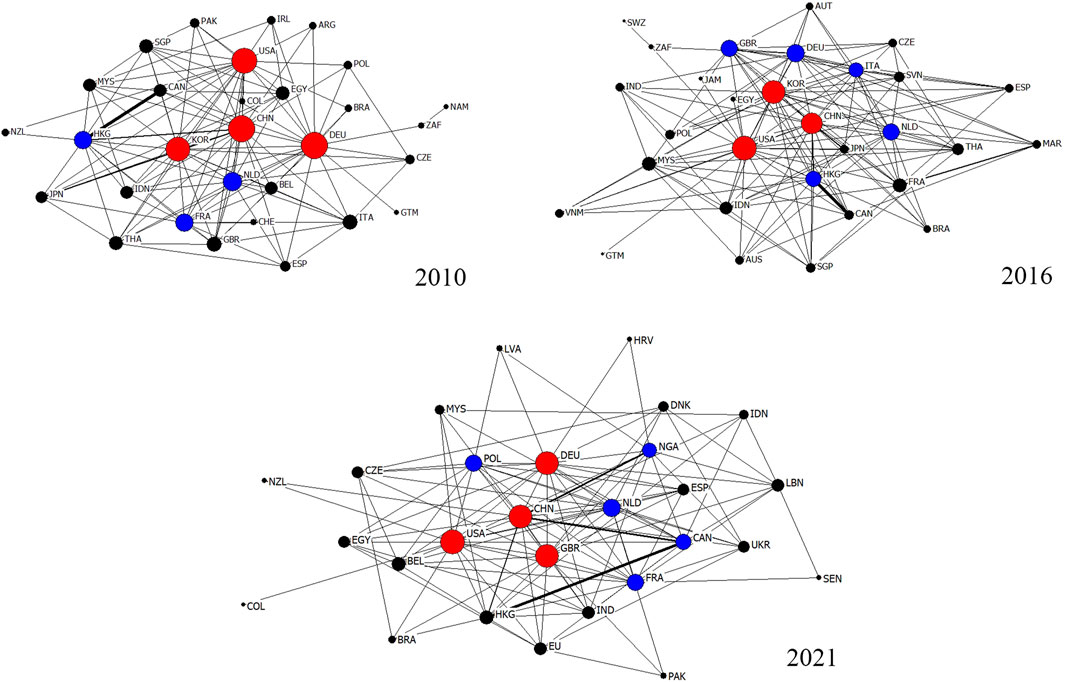
FIGURE 2. GGTNs in 2010, 2016, and 2021. Note: Each node denotes a country using ISO alpha-3 abbreviation. See Supplementary Appendix Table SA4. for the country codes.
Figure 3 demonstrates the changes in network density, average path length (APL), and clustering coefficient (C) of GGTNs over time. The density exhibited a general growth trend with fluctuations. The highest network density observed was 0.099 in 2018, while the lowest density was record as 0.046 in 2017. This result indicates a relatively stable ginseng trade. The APL value ranged from 2.35 to 2.82, which implied that any two nodes within the GGTNs could be connected through an average of less than three nodes. Simultaneously, the C value ranged from 0.45 to 0.98 and exhibited a continuous increase from 2013 to 2021. Notably, the maximum APL value was more than six times greater than the minimum C value. The opposite trends of them indicate that GGTNs has typical small-world characteristics.

FIGURE 3. Network density (D), average path length (L), and clustering coefficient (C) of GGTNs from 2010 to 2021.
3.2 Nodes attribution
In this study, the node degree was ranked from small to large, and the top 10 nodes in 2010, 2016 and 2021were identified and presented in Table 3. Although the ranking of node degrees varied over times, certain key countries such as China, South Korea, Germany, the United States and Britain consistently ranked among the top positions. The United States and Germany maintained their strong positions in import market, indicating their significant market demand for ginseng. South Korea and China ranked first and second, respectively, in the out-degree rankings in 2010 and 2016, highlighting their substantial export advantage due to their notable resource endowments. However, Germany emerged rapidly and surpassed South Korea to become the top-ranked country in 2021. The results of betweenness centrality revealed that China and South Korea were the main connector hubs of GGTNs in 2010 and 2016. However, in 2021, Lebanon and the United States replaced them in this role. The above analysis focused on the number of trading partners for each node. Further research on the top ten trade routes based on trade volume indicated that countries with a higher numbers of trading partners also tended to have higher transaction volumes. The data can be founded in Table 4.
Power function fittings were conducted to analyze the node degree distribution in GGTNs and both fittings passed the significance test. A comparison of the node degree distribution curves for 2010, 2016, and 2021 revealed a typical “long-tail” distribution pattern. This indicates that a few nodes in the networks had high degree values, while the majority had small and similar degree values (Figure 4). The node degree distribution followed a power-law distribution indicating the ginseng trade exhibits scale-free characteristics. However, the feature was weakening over time, as evidenced by the decreased in the power ratio fitting value (R2) since 2010. This suggests that GGTNs may become more decentralized and diversified in the future.
3.3 Core-periphery structure analysis
The participating countries in GGTNs for the years 2010, 2016, and 2021 were categorized into three groups based on their core values. Countries with core values greater than 0.2 were classified as core countries, those between 0.1 and 0.2 were classified as semi-periphery countries, and those below 0.1 were classified as periphery countries. The analysis revealed a significant decline in the number of core countries, with six core countries in 2021, compared to nine in 2016 and seven in 2010. As shown in Table 5, Germany, the United States, and China firmly hold core positions, with their core value greater than 0.3. Germany, in particular, has become the top-ranking country in terms of both core value and node degree. Conversely, countries like South Korea and Hong Kong China have changed from being core countries to semi-periphery countries, indicating a decline in their positions. On the other hand, there has been a substantial increase in the number of semi-periphery countries, with eleven in 2010, fourteen in 2016 and seventeen in 2021. This trend is noteworthy due to the large numbers and the potential market opportunities these countries represent. Regional variations were observed within the semi-periphery countries, with a decrease in core values for Asian countries such as Japan, Singapore, Thailand, and an increase for European countries like Spain and Italy. Most of the core and semi-periphery countries, such as China, Japan, Singapore, Thailand are along the “Belt and Road” (BRI). It is worth investigating the factors influencing GGTNs, as the geographic proximity and cultural similarities, particularly among countries along the BRI initiative, may play a significant role.
3.4 Analysis of influencing factors
3.4.1 QAP correlation analysis
In this study, a correlation analysis was conducted between the ginseng trade matrix and its impact factors for the years 2010, 2016, and 2021. A total of 5,000 random permutations were performed for statistical analysis.
Table 6 presents the results of the correlation analysis. It is evident that geographic distance, land border, GDP, technology differences and membership of IRCH organization had significant effects on GGTNs at a 1% significance level. Among these factors, geographic distance showed a negative correlation with the network, suggesting that greater distance between countries, the lower trade volume. Additionally, GDP_per also exhibited a negative correlation with the network. The correlation coefficients for population, religion and language were relatively small, and their significance varied sporadically. This implies that these factors had limited overall influence on the ginseng trade network in the mentioned years.
3.4.2 QAP regression analysis
To further explore the statistical significance of the explanatory variables, QAP regression analysis was conducted. The regression results for the year 2010, 2016 and 2021 are shown in Table 7.
The analysis revealed that geographic distance and land adjacency were consistently significant factors with the greatest impact on GGTNs over the long term. Specifically, the coefficient of geographic distance was statistically negative at a 1% critical level for all 3 years, suggesting that the shorter geographic distance, the higher level of trading volumes. This finding aligns with the previous literature that high transportation costs encourage countries to trade with partners located closer to them. The significant impact of land borders suggests the presence of a noticeable “boundary effect” in ginseng trade. Countries in close proximity may share similar cultures and lifestyles, leading to lower construction and management costs and more flexible railway transportation. For example, the analysis of the top 10 trade routes revealed that China has maintained increasingly close trade relation with its neighbors. However, the influence of land borders may be diminishing due to the availability of alternative transportation modes such as marine and air freight.
Furthermore, in the year 2021, the coefficient of economic proximity and population showed a positive and statistically significant relationship with GGTNs, whereas in 2010 and 2016, these variables did not demonstrate significant effects. This suggests that countries with higher levels of economic development and significant population disparities tend to engage in more frequent ginseng trade. The underlying reason for this finding could be attributed to the resource-intensive and labor-intensive nature of ginseng industry. Countries with different economic scale and population size possess diverse comparative advantages, which can be mutually beneficial through international trade. The availability of complementary resources and labor forces encourages trade interactions between countries with different economic and population characteristics, leading to increased ginseng trade volumes.
The influence of economic proximity and population on GGTNs is consistent with the characteristics of the top 10 trade nodes, which predominantly include developed countries such as China and the United States. However, an interesting finding in 2021 was opposite impact of GDP_per compared to GDP in 2021. Countries with similar GDP_per capita are more likely to establish trade relationships for ginseng products. One possible explanation for this is that people with similar income level tend to have similar consumption behaviors and habits. Hence, countries with comparable level of GDP_per capita may share common preferences and demand patterns, facilitating trade collaborations in the ginseng industry.
Religion and language were found to be positive factors influencing GGTNs, but their significance was observed only in 2010, and showed a declining trend over time. This finding implies that ginseng trade initially benefited from similar culture backgrounds, but with the advancement of economic globalization, cultural barriers in GGTNs have been progressively diminished. One the other hand, technology similarity exhibited a positive and long-term significant influence at a 1% level. This result is consistent with previous studies indicating that technological proximity facilitated trade and scientific research (Milani, 2020). As ginseng is a medicinal plant, its medicinal value can be better understood and appreciated by members of the IRCH organization, thus facilitating its promotion, application and supervision. The factor analysis showed that membership in the IRCH organization had a significant positive effect on ginseng trade, and its effect has increased over time.
3.4.3 Robustness test
To ensure the robustness of the QAP regression results, a variable exclusion test was conducted to assess the stability of the findings. The results of the variable exclusion tests in 2010, 2016 and 2021 demonstrated the robustness of the QAP regression analysis. When one variable was removed, the regression coefficient and significance levels of the remaining variables generally remained consistent with the original results.
There are several minor changes observed in the variable exclusion tests, in 2010, when the technology variable was excluded, the regression coefficient of GDP difference changed from negative to positive and became significant. In 2016, when technology variable was excluded, the coefficient of population changed from negative to positive, but it was not statistically significant. In 2021, when geographic distance variable was excluded, the coefficient of religion difference varied from negative to positive, but it was not statistically significant. The detailed results of the robustness test are presented in Supplementary Appendix Table SA1–SA3, due to space limitations in the main article.
4 Conclusion and discussion
4.1 Conclusion
In this study, we use ginseng trade data spanning 2010 to 2021 to construct global ginseng trade networks and analyze its structural characteristics using social network analysis. We further investigate the influencing factors of ginseng trade by quadratic assignment procedure. There are several interesting findings.
Firstly, SNA research has demonstrated typical characteristics such as scale-free distribution, small-world characteristics and high clustering coefficients in ginseng trade relations. This finding is consistent with the characteristics observed in international trade networks (Serrano and Boguñá, 2003; Zhong et al., 2014). They indicate that ginseng trade has been concentrated among certain active participating countries over the past decade. Additionally, core-periphery analysis was conducted to further investigate the specific trade groups within the ginseng trade network. This analysis confirmed the presence of distinct trade groups consisting of core and semi-periphery countries.
Secondly, several core countries, including China, South Korea, Germany, and the United States, play a dominant role in terms of both trade volume and trade partners within the ginseng trade networks. Initially, South Korea and China held central positions in the export market due to their resource endowments. However, their prominence has gradually diminished with the rise of Germany and the United States. Furthermore, core-periphery analysis found that most of the active participating countries in the ginseng trade are along the “Belt and Road” religion.
Finally, QAP results reveal that geographic distance and GDP per capita have negative impacts on ginseng trade, indicating that countries that are geographically distant and have lower GDP per capita tend to engage in less trade in ginseng. On the other hand, factors such as land adjacency, technology and economic gap, population size, and institution similarity were found to have significant positive effects on ginseng trade. These result helps us to better understand the complex ginseng trade relationships and thus to formulate trade policies.
4.2 Theoretical contributions and limitations
In this paper, we provide a novel perspective to study the ginseng trade relations. Importantly, our study reveals the typical characteristics including scale-free distribution, small-world characteristics and high clustering coefficients in ginseng trade relations. This finding extends the literature on trade in ethnic medicine. Also, our findings suggest that GGTNs have become increasingly concentrated and interconnected among a few exporters with abundant resources, as well as consumers who value intellectual property rights and brand advantages. Interesting, the resource endowments of these exporters have been gradually eroded due to advancements in deep processing technology and most of the active participating countries are along the “Belt and Road” religion. Additionally, our study enriches the theoretical literature on the dynamics of international trade by confirming the impact of geographic distance, GDP per capita, land adjacency, technology and economic gap, population size, and institution similarity.
Despite the contributions herein, this work has several limitations. The study on GGTNs should not only focus on the national level, but also extend to regional alliances. Other factors such as medical insurance policy differences that have an impact on the ginseng trade are yet to be explored.
4.3 Practical implications
4.3.1 Commerce and conservation
It is crucial to highlight the relationship between the responsible use of resources and sustainable trade in ginseng trade. The rational utilization of resources plays a pivotal role in ensuring the long-term sustainability of the economy, and the level of economic development significantly influences the pattern of resource exploitation. It is imperative that trade activities do not jeopardize the survival of species or contribute to their extinction.
We firmly advocate for the pursuit of sustainable development in ginseng trade, similar to the approaches adopted in food and energy trade. This necessitates the establishment of a consensus and cooperation among all participating countries engaged in ginseng trade. Furthermore, it is essential for international organizations such as the IRCH organization to actively engage and implement oversight measures to ensure sustainable practices are followed.
4.3.2 More diversified products, more secure trade
Expanding trade channels and adopting trade substitution measures are essential to improve trade security, given the similar market structure and high barriers in ginseng trade. Currently, the export of high value-added and high-tech ginseng patent medicines, healthcare products and cosmetics is limited. Certain ginseng medicinal products, such as ginseng herbal tablets and single-herb granules face legal restrictions in some countries because of legal barrel (Moorhouse et al., 2021). To bridge the gap between the Chinese and Western cultures as well as their dissimilar medical systems, the government should leverage business cooperation and culture exchanges to explore the overseas markets, especially potential semi-periphery markets. It is crucial to foster an understanding of traditional Chinese medicine culture as a precondition for the acceptance of Chinese medicine (Yu et al., 2022). Furthermore, it is essential for governments and enterprises to recognize the importance of expediting legislation, strengthening high-level contacts and dialogs, and studying and using existing laws, regulations, and traditional drug management practices. These actions are necessary to expand offshore markets in a comprehensive manner.
4.3.3 Standardized production and quality improvement
To enhance the quality and safety of ginseng products and improve market competitiveness, the implementation of standardized production and brand management practices is crucial. Currently, more than 60% of Chinese medicines face barriers to entry in foreign markets due to “green barriers” (Cunningham et al., 2018). To address concerns and doubts regarding the safety and efficacy of ginseng, it is essential to establish a quality standard system that aligns with international standards across various stages, including the sourcing of herbs, extraction and separation processes, research, development, production, and quality control.
Furthermore, fostering exchanges and cooperation between Traditional Chinese Medicine colleges, research institutions, clinical institutions, and peers should be encouraged and supported. As the efficacy of TCM becomes widely recognized, an increasing number of research institutions are expected to contribute to deeper investigations on further processed products and high-value ginseng products.
Data availability statement
The original contributions presented in the study are included in the article/Supplementary Material, further inquiries can be directed to the corresponding author.
Author contributions
YF (first author): Conceptualization, writing-original draft preparation MT: Data curation, software HW: Methodology, data curation, software ZF: Software, supervision. NY (corresponding author): Writing-Reviewing and Editing. All authors contributed to the article and approved the submitted version.
Funding
This study was supported by the Social Science Planning Project of Anhui Province under Grant number 2022AH050424 and Philosophy and Social Science of Anhui Province under Grant number AHSKY2021D143.
Conflict of interest
The authors declare that the research was conducted in the absence of any commercial or financial relationships that could be construed as a potential conflict of interest.
Publisher’s note
All claims expressed in this article are solely those of the authors and do not necessarily represent those of their affiliated organizations, or those of the publisher, the editors and the reviewers. Any product that may be evaluated in this article, or claim that may be made by its manufacturer, is not guaranteed or endorsed by the publisher.
Supplementary material
The Supplementary Material for this article can be found online at: https://www.frontiersin.org/articles/10.3389/fphar.2023.1119183/full#supplementary-material
Abbreviations
SNA, Social Network Analysis; QAP, Quadratic Assignment Procedure; GGTNs, Global Ginseng Trade Networks; CAGR, Compound annual growth rate; N, Node; D, Density; L, Average Path Length; C, Clustering Coefficient; K, Node-Degree; BC, Betweenness Centrality.
References
An, P., Li, H., Zhou, J., and Chen, F. (2017). The evolution analysis of listed companies co-holding non-listed financial companies based on two-mode heterogeneous networks. Phys. A 484 (C), 558–568. doi:10.1016/j.physa.2017.04.095
Anderson, J. E., and Van Wincoop, E. (2003). Gravity with gravitas: A solution to the border puzzle. Amer Econ. Rev. 93 (1), 170–192. doi:10.1257/000282803321455214
Baeg, I. H., and So, S. H. (2013). The world ginseng market and the ginseng (Korea). J. Ginseng Res. 37 (1), 1–7. doi:10.5142/jgr.2013.37.1
Bergstrand, J. H. (1989). The generalized gravity equation, monopolistic competition, and the factor-proportions theory in international trade. Rev. Econ. Stat. 71, 143–153. doi:10.2307/1928061
Borgatti, S., and Everett, M. (1999). Models of core/periphery structures. Soc. Netw. 21, 375–395. doi:10.1016/S0378-8733(99)00019-2
Carlson, A. W. (1986). Ginseng: America’s botanical drug connection to the orient. Econ. Bot. 40 (2), 233–249. doi:10.1007/BF02859148
Chen, C. F., Chiou, W. F., and Zhang, J. T. (2008). Comparison of the pharmacological effects of Panax ginseng and Panax quinquefolium. Acta Pharmacol. Sin. 29 (9), 1103–1108. doi:10.1111/j.1745-7254.2008.00868.x
Chen, E. Y., and Hui, C. L. (2012). HT1001, a proprietary North American ginseng extract, improves working memory in schizophrenia: A double-blind, placebo-controlled study. Phytother. Res. 26 (8), 1166–1172. doi:10.1002/ptr.3700
Choi, S. H., Jung, S. W., Lee, B. H., Kim, H. J., Hwang, S. H., Kim, H. K., et al. (2015). Ginseng pharmacology: A new paradigm based on gintonin-lysophosphatidic acid receptor interactions. Front. Pharmacol. 6, 245. doi:10.3389/fphar.2015.00245
Cunningham, A., Brinckmann, J., Kulloli, R., and Schippmann, U. (2018). Rising trade, declining stocks: The global gugul (Commiphora wightii) trade. J. Ethnopharmacol. 223, 22–32. doi:10.1016/j.jep.2018.04.040
Dekker, D., Krackhardt, D., and Snijders, T. A. (2007). Sensitivity of MRQAP tests to collinearity and autocorrelation conditions. Psychometrika 72 (4), 563–581. doi:10.1007/s11336-007-9016-1
Duan, J., Nie, C., Wang, Y., Yan, D., and Xiong, W. (2021). Research on global grain trade network pattern and its driving factors. Sustainability 14 (1), 245. doi:10.3390/su14010245
Elliott, A., Chiu, A., Bazzi, M., Reinert, G., and Cucuringu, M. (2020). Core–periphery structure in directed networks. Proc. R. Soc. A 476 (2241), 20190783. doi:10.1098/rspa.2019.0783
Fagiolo, G., Reyes, J., and Schiavo, S. (2009). World-trade web: Topological properties, dynamics, and evolution. Phys. Rev. E Stat. Nonlin Soft Matter Phys. 79 (3 Pt 2), 036115. doi:10.1103/PhysRevE.79.036115
Fagiolo, G. (2010). The international-trade network: Gravity equations and topological properties. J. Econ. Interact. Coord. 5 (1), 1–25. doi:10.1007/s11403-010-0061-y
Fan, J. W., Xu, X. T., Cheng, H., Sang, Z., and Shi, Y. H. (2023). Standardization of panax ginseng: Current status of global trade, demands, and development. Am. J. Chin. Med. 51, 909–927. doi:10.1142/s0192415x23500428
Flagg, A. J. (2021). Traditional and current use of ginseng. Nurs. Clin. North Am. 56 (1), 109–121. doi:10.1016/j.cnur.2020.10.011
Fu, Y., Xue, L., Yan, Y., Pan, Y., Wu, X., and Shao, Y. (2021). Energy network embodied in trade along the belt and road: Spatiotemporal evolution and influencing factors. Sustainability 13 (19), 10530. doi:10.3390/su131910530
Gao, C., Sun, M., and Shen, B. (2015). Features and evolution of international fossil energy trade relationships: A weighted multilayer network analysis. Appl. energy 156, 542–554. doi:10.1016/j.apenergy.2015.07.054
Geng, J., Dong, J., Ni, H., Lee, M. S., Wu, T., Jiang, K., et al. (2010). Ginseng for cognition. Cochrane Database Syst. Rev. 12, Cd007769. doi:10.1002/14651858.CD007769.pub2
Gotlieb, M. J. (1985). George drew and the dominion-provincial conference on reconstruction of 1945–6. Can. Hist. Rev. 66 (1), 27–47. doi:10.3138/chr-066-01-02
Guan, Q., An, H., Gao, X., Huang, S., and Li, H. (2016). Estimating potential trade links in the international crude oil trade: A link prediction approach. Energy 102, 406–415. doi:10.1016/j.energy.2016.02.099
Hu, X., Wang, C., Lim, M. K., and Chen, W.-Q. (2020). Characteristics of the global copper raw materials and scrap trade systems and the policy impacts of China's import ban. Ecol. Econ. 172, 106626. doi:10.1016/j.ecolecon.2020.106626
Jeong, H. G., Ko, Y. H., Oh, S. Y., Han, C., Kim, T., and Joe, S. H. (2015). Effect of Korean Red Ginseng as an adjuvant treatment for women with residual symptoms of major depression. Asia Pac Psychiatry 7 (3), 330–336. doi:10.1111/appy.12169
Ji, L., Jia, X., Chiu, A. S., and Xu, M. (2016). Global electricity trade network: Structures and implications. PLoS One 11 (8), e0160869. doi:10.1371/journal.pone.0160869
Kabir, M., Salim, R., and Al-Mawali, N. (2017). The gravity model and trade flows: Recent developments in econometric modeling and empirical evidence. Econ. Analysis Policy 56, 60–71. doi:10.1016/j.eap.2017.08.005
Kim, H. G., Cho, J. H., Yoo, S. R., Lee, J. S., Han, J. M., Lee, N. H., et al. (2013). Antifatigue effects of panax ginseng C.A. Meyer: A randomised, double-blind, placebo-controlled trial. PLoS One 8 (4), e61271. doi:10.1371/journal.pone.0061271
Lee, C. S., Lee, J. H., Oh, M., Choi, K. M., Jeong, M. R., Park, J. D., et al. (2012). Preventive effect of Korean red ginseng for acute respiratory illness: A randomized and double-blind clinical trial. J. Korean Med. Sci. 27 (12), 1472–1478. doi:10.3346/jkms.2012.27.12.1472
Leibenstein, H., and Tinbergen, J. (1966). Shaping the world economy: Suggestions for an international economic policy. Econ. J. 76 (301), 92–95. doi:10.2307/2229041
Li, J., Chen, G., Hayat, T., and Alsaedi, A. (2015). Mercury emissions by beijing׳ s fossil energy consumption: Based on environmentally extended input–output analysis. Renew. Sustain. Energy Rev. 41, 1167–1175. doi:10.1016/j.rser.2014.08.073
Liu, J. (2004). An introduction to social network analysis. Beijing: Social Sciences Academic Press, 24–26.
Liu, Y., and Tsai, S.-B. (2022). Dynamic evolution of service trade network structure and influence mechanism in countries along the “belt and road” with big data analysis. Math. Problems Eng. 2022, 1–13. doi:10.1155/2022/8378137
Mancuso, C., and Santangelo, R. (2017). Panax ginseng and Panax quinquefolius: From pharmacology to toxicology. Food Chem. Toxicol. 107 (Pt A), 362–372. doi:10.1016/j.fct.2017.07.019
Milani, S. (2020). Who innovates with whom and why? Evidence from international collaboration in energy patenting. Econ. Innovation New Technol. 29 (4), 369–393. doi:10.1080/10438599.2019.1629531
Moorhouse, T. P., Elwin, A., Ye, Y.-C., Zhou, Z.-M., Cruze, N. C., and Macdonald, D. W. (2021). Beyond the Pharmacopoeia: To what extent is trade for “TCM” limited to official TCM taxa? Glob. Ecol. Conservation 32, e01906. doi:10.1016/j.gecco.2021.e01906
Newman, M. E., and Park, J. (2003). Why social networks are different from other types of networks. Phys. Rev. E Stat. Nonlin Soft Matter Phys. 68 (3 Pt 2), 036122. doi:10.1103/PhysRevE.68.036122
Nobi, A., Lee, T. H., and Lee, J. W. (2020). Structure of trade flow networks for world commodities. Phys. A Stat. Mech. its Appl. 556, 124761. doi:10.1016/j.physa.2020.124761
Ossoukhova, A., Owen, L., Savage, K., Meyer, M., Ibarra, A., Roller, M., et al. (2015). Improved working memory performance following administration of a single dose of American ginseng (Panax quinquefolius L.) to healthy middle-age adults Hum. Psychopharmacol. 30 (2), 108–122. doi:10.1002/hup.2463
Reyes, L., and Laroze, D. (2022). Cellular Automata for excitable media on a Complex Network: The effect of network disorder in the collective dynamics. Phys. A Stat. Mech. its Appl. 588 (C), 126552. doi:10.1016/j.physa.2021.126552
Ristanovic, V., Primorac, D., and Kozina, G. (2020). Applying gravity model to analyse trade direction. Teh. Vjesn. 27 (5), 1670–1677. doi:10.17559/tv-20200217101315
Scholey, A., Ossoukhova, A., Owen, L., Ibarra, A., Pipingas, A., He, K., et al. (2010). Effects of American ginseng (panax quinquefolius) on neurocognitive function: An acute, randomised, double-blind, placebo-controlled, crossover study. Psychopharmacol. Berl. 212 (3), 345–356. doi:10.1007/s00213-010-1964-y
Serrano, M. A., and Boguñá, M. (2003). Topology of the world trade web. Phys. Rev. E Stat. Nonlin Soft Matter Phys. 68 (1 Pt 2), 015101. doi:10.1103/PhysRevE.68.015101
So, S. H., Lee, J. W., Kim, Y. S., Hyun, S. H., and Han, C. K. (2018). Red ginseng monograph. J. Ginseng Res. 42 (4), 549–561. doi:10.1016/j.jgr.2018.05.002
Sui, G., Zou, J., Wu, S., and Tang, D. (2021). Comparative studies on trade and value-added trade along the “belt and road”: A network analysis. Complexity 2021, 1–12. doi:10.1155/2021/3994004
Szczuka, D., Nowak, A., Zakłos-Szyda, M., Kochan, E., Szymańska, G., Motyl, I., et al. (2019). American ginseng (panax quinquefolium L.) as a source of bioactive phytochemicals with pro-health properties Nutrients 11 (5), 1041. doi:10.3390/nu11051041
Vu, T. T. H., Tian, G., Zhang, B., and Nguyen, T. V. (2020). Determinants of vietnam's wood products trade: Application of the gravity model. J. SUSTAIN For. 39 (5), 445–460. doi:10.1080/10549811.2019.1682011
Walker, S. (2018). Cultural barriers to market integration: Evidence from 19th century Austria. J. Comp. Econ. 46 (4), 1122–1145. doi:10.1016/j.jce.2018.05.001
Wang, C., Huang, X., Lim, M. K., Tseng, M.-L., and Ghadimi, P. (2020). Mapping the structural evolution in the global scrap copper trade network. J. Clean. Prod. 275, 122934. doi:10.1016/j.jclepro.2020.122934
Wu, X., Chen, G., Xiong, H. R., Zheng, Z. W., Zhou, J., et al. (2019). Global overview of crude oil use: From source to sink through inter-regional trade. Energy Policy 128, 476–486. doi:10.1016/j.enpol.2019.01.022
Xiang, L., Chen, Z., Wei, S., and Zhou, H. (2022). Global trade pattern of traditional Chinese medicines and China's trade position. Front. Public Health 10, 865887. doi:10.3389/fpubh.2022.865887
Xin, G. J., Zhao, Y. W., Li, L. M., Jia, F. F., Han, X., Li, L., et al. (2021). Mechanism of 'invigorating Qi and promoting blood circulation' drug pair ginseng-danshen on treatment of ischemic heart disease based on network pharmacology. Chin. J. Integr. Med. 27 (6), 440–445. doi:10.1007/s11655-021-2859-y
Xu, H., and Cheng, L. (2016). The QAP weighted network analysis method and its application in international services trade. Phys. A Stat. Mech. its Appl. 448, 91–101. doi:10.1016/j.physa.2015.12.094
Yennurajalingam, S., Reddy, A., Tannir, N. M., Chisholm, G. B., Lee, R. T., Lopez, G., et al. (2015). High-Dose asian ginseng (panax ginseng) for cancer-related fatigue: A preliminary report. Integr. Cancer Ther. 14 (5), 419–427. doi:10.1177/1534735415580676
Yanchenko, E., and Sengupta, S. (2022). Core-periphery structure in networks: A statistical exposition. Available at: https://ui.adsabs.harvard.edu/abs/2022arXiv220204455Y (Accessed February 01, 2022).
Yotov, Y. (2022). On the role of domestic trade flows for estimating the gravity model of trade. Contemp. Econ. Policy 40 (3), 526–540. doi:10.1111/coep.12567
Yu, Z.-B., Dong, S.-H., Zhang, J.-W., Li, D.-Y., Liu, Y., Li, H., et al. (2022). Analysis of international competitiveness of the China's licorice industry from the perspective of global trade. J. Ethnopharmacol. 298, 115613. doi:10.1016/j.jep.2022.115613
Zhong, W., An, H., Gao, X., and Sun, X. (2014). The evolution of communities in the international oil trade network. Phys. A Stat. Mech. its Appl. 413 (C), 42–52. doi:10.1016/j.physa.2014.06.055
Keywords: ginseng trade, structural characteristics, influencing factors, social network analysis, quadratic assignment procedure
Citation: Fang Y, Tang M, Wei H, Feng Z and Yu N (2023) Global ginseng trade networks: structural characteristics and influencing factors. Front. Pharmacol. 14:1119183. doi: 10.3389/fphar.2023.1119183
Received: 13 February 2023; Accepted: 22 June 2023;
Published: 10 July 2023.
Edited by:
Adolfo Andrade-Cetto, National Autonomous University of Mexico, MexicoReviewed by:
Li-Wei Sun, The Affiliated Hospital of Changchun University of Traditional Chinese Medicine, ChinaPrashant Kaushik, Yokohama Ueki, Japan
Copyright © 2023 Fang, Tang, Wei, Feng and Yu. This is an open-access article distributed under the terms of the Creative Commons Attribution License (CC BY). The use, distribution or reproduction in other forums is permitted, provided the original author(s) and the copyright owner(s) are credited and that the original publication in this journal is cited, in accordance with accepted academic practice. No use, distribution or reproduction is permitted which does not comply with these terms.
*Correspondence: Nianjun Yu, rscszk@ahtcm.edu.cn
 Yue Fang1
Yue Fang1 Nianjun Yu
Nianjun Yu